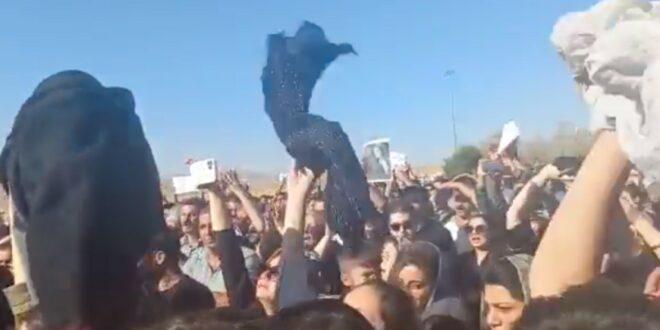Mahsa Amini’s death ignited a wave of protests against the government.
Iranian security forces opened fire on Saturday on a crowd of protesters mourning the death of 22-year-old Mahsa Amini following her arrest by the “guidance patrol,” a police unit in charge of enforcing mandatory hijab rules.
According to Hengaw, a media organization monitoring the human rights situation in Iran, at least 13 people were injured, one of them in critical condition, after riot police opened fire and threw gas canisters at a protest venue outside the governor’s office in Mahsa’s hometown, the Kurdish city of Saghez.
The violence occurred as security officials rushed the woman’s burial early Friday morning in anticipation of protests. Roads to Saghez were also blocked to bar the entry of mourners from adjacent cities, while internet connection was severely disrupted, local activists reported on social media, adding that intelligence officials had confiscated mobile phones belonging to the deceased woman’s family members.
“Death to the dictator,” the protesters were heard chanting, repeating a slogan that has increasingly themed Iranian protests in recent years, and which appears directed at Supreme Leader Ayatollah Ali Khamenei. One video also showed a Khamenei banner torn apart by some protesters. And defying the strict hijab law, some women lifted their headscarves during the funeral, dismissing it as “humiliation”.
The hard-liners’ version
The protests were given passing coverage by some pro-government outlets, including Fars news agency, affiliated with the Islamic Revolutionary Guard Corps (IRGC). “The rallies died down after tear gas from police forces,” Fars reported.
Earlier the news agency insisted that the woman had suffered a heart attack. It cited an “informed medical source” as saying she was already suffering from background health issues, with a history of epilepsy.
Yet the Legal Medicine Organization has announced that its examinations to establish the exact causes of the death are still under way and will be submitted to the judiciary within three weeks.
And Kasra Hospital, where Mahsa received intensive care, has issued a statement noting that upon admission at the center, the patient was already brain dead.
Official narrative challenged
Mahsa was pronounced dead on Friday, two days after slipping into a coma following her arrest. Police immediately denied torture allegations and linked her death to a “sudden heart attack.”
Hours into Mahsa’s death, state television aired a short CCTV clip of what was said to be a “hijab class” where she along with other detained women were seated to receive “guidance.” In the video, she appears to pass out and collapse on the ground while negotiating her release with a female staff. The clip, however, misses the moments of her arrest and the travel inside the police van, leaving room for speculation from Iranians who have raised the likelihood of a life-threatening beating to the head and subsequent brain injury, which left her comatose later inside the police station.
The argument has been backed up by a picture of the bed-ridden victim, showing swollen black eyes and stains of bleeding from her ears, as symptoms of some traumatic brain injury to the skull base.
In an Instagram story posted on Saturday, the state TV presenter who read out a police statement on the video further complicated the speculations. “I do believe that we journalists will be punished in the afterlife not for what we have said, rather for what we have not.”
The death drew reactions even from certain sectors of the clergy. “Whatever the cause of Mahsa Amini’s death, those behind the tragedy should be held accountable,” the Association of Combatant Clerics announced in a statement.
Unconvinced by the official explanations, many Iranian women shared their personal experiences with hijab police brutality, as one video was repeatedly reposted showing a Khamenei speech, in which he appears to suggest serious action is warranted against hijab violators.
The debate also went further, as many dug up human rights violations and the Islamic Republic’s shrugging off of criticism, from other cases of deaths in custody and the killing of protesters, to the IRGC downing of a Ukraine Airlines flight in 2020, which killed 176 on board, yet was vehemently denied by Iranian authorities for three days.
‘You will live on as an icon’
To many Iranians, especially women, Mahsa appeared as an embodiment of their suffering, suppression and justice that remains unserved.
“That notorious building will someday be transformed and named ‘the museum of oppression against women’,” one Iranian Twitter user wrote, referring to a central Tehran police department where women arrested over hijab violations are commonly transferred to, the same place in which Mahsa collapsed.
“You haven’t died, you will live on as an icon,” read the photo of a hand-written message left on Mahsa’s grave, which made rounds on social media.
 Eurasia Press & News
Eurasia Press & News



